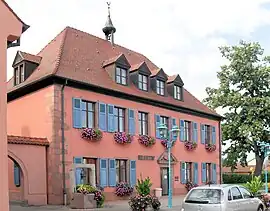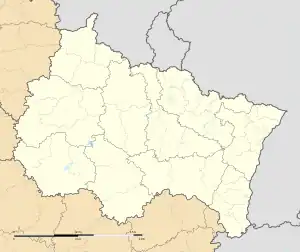Bollwiller | |
|---|---|
 The town hall in Bollwiller | |
.svg.png.webp) Coat of arms | |
Location of Bollwiller | |
 Bollwiller  Bollwiller | |
| Coordinates: 47°51′29″N 7°15′46″E / 47.8581°N 7.2628°E | |
| Country | France |
| Region | Grand Est |
| Department | Haut-Rhin |
| Arrondissement | Mulhouse |
| Canton | Wittenheim |
| Intercommunality | Mulhouse Alsace Agglomération |
| Government | |
| • Mayor (2020–2026) | Jean-Paul Julien[1] |
| Area 1 | 8.63 km2 (3.33 sq mi) |
| Population | 4,109 |
| • Density | 480/km2 (1,200/sq mi) |
| Time zone | UTC+01:00 (CET) |
| • Summer (DST) | UTC+02:00 (CEST) |
| INSEE/Postal code | 68043 /68540 |
| Elevation | 229–265 m (751–869 ft) (avg. 235 m or 771 ft) |
| 1 French Land Register data, which excludes lakes, ponds, glaciers > 1 km2 (0.386 sq mi or 247 acres) and river estuaries. | |
Bollwiller (French pronunciation: [bɔlvilɛʁ] ⓘ; German: Bollweiler) is a commune in the Haut-Rhin department in Grand Est in north-eastern France.[3] It forms part of the Mulhouse Alsace Agglomération, the inter-communal local government body for the Mulhouse conurbation.[4] Château de Bollwiller became a Monument historique in 2007.
Population
| Year | Pop. | ±% p.a. |
|---|---|---|
| 1968 | 2,846 | — |
| 1975 | 3,007 | +0.79% |
| 1982 | 2,951 | −0.27% |
| 1990 | 3,194 | +0.99% |
| 1999 | 3,552 | +1.19% |
| 2007 | 3,565 | +0.05% |
| 2012 | 3,695 | +0.72% |
| 2017 | 4,027 | +1.74% |
| Source: INSEE[5] | ||
See also
References
- ↑ "Répertoire national des élus: les maires". data.gouv.fr, Plateforme ouverte des données publiques françaises (in French). 2 December 2020.
- ↑ "Populations légales 2021". The National Institute of Statistics and Economic Studies. 28 December 2023.
- ↑ INSEE commune file
- ↑ "Mulhouse Alsace Agglomération". Mulhouse Alsace Agglomération. Retrieved 2011-04-07.
- ↑ Population en historique depuis 1968, INSEE
Wikimedia Commons has media related to Bollwiller.
This article is issued from Wikipedia. The text is licensed under Creative Commons - Attribution - Sharealike. Additional terms may apply for the media files.